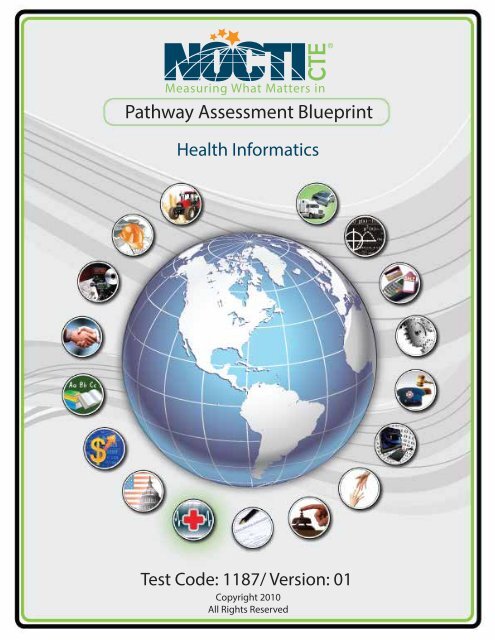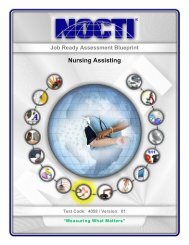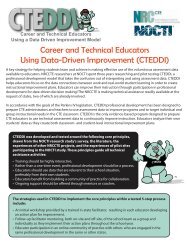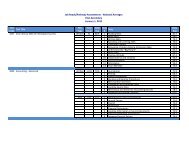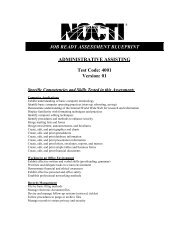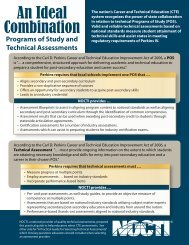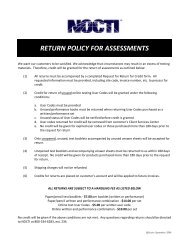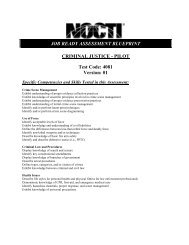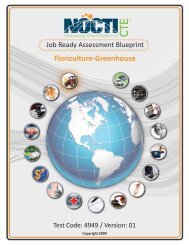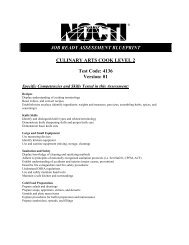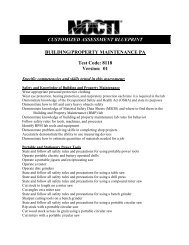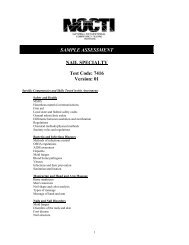Health Informatics - nocti
Health Informatics - nocti
Health Informatics - nocti
Create successful ePaper yourself
Turn your PDF publications into a flip-book with our unique Google optimized e-Paper software.
Measuring What Matters in<br />
Pathway Assessment Blueprint<br />
<strong>Health</strong> <strong>Informatics</strong><br />
Test Code: 1187/ Version: 01<br />
Copyright 2010<br />
All Rights Reserved
<strong>Health</strong> <strong>Informatics</strong><br />
General Assessment Information<br />
General Assessment Information<br />
Written Assessment Information<br />
Blueprint Contents<br />
Sample Written Items<br />
Specific Competencies Covered in the Test<br />
Test Type: The <strong>Health</strong> <strong>Informatics</strong> assessment is included in NOCTI’s Pathway<br />
assessment battery. Pathway assessments assess knowledge and skills at a broader<br />
level than the Job Ready assessments and focus on the Pathways established as part of<br />
the national career cluster model. Pathway assessments are delivered entirely online<br />
which allows NOCTI to include engaging interactive items.<br />
Revision Team: The assessment content is based on input from secondary,<br />
post-secondary, and business/industry representatives from the states of Kentucky,<br />
Minnesota, New York, North Carolina, and Pennsylvania.<br />
CIP<br />
Code<br />
51.0799-<strong>Health</strong> and Medical<br />
Administrative Services, Other<br />
Career Cluster 8-<strong>Health</strong> Services<br />
The American Medical Certification Association (AMCA) established as a division<br />
of the American School of Business, offers 14 certification exams for the allied<br />
healthcare field. AMCA supports NOCTI's <strong>Health</strong> Science assessments which are<br />
aligned to industry standards. This assessment is an excellent training instrument,<br />
in both content and test-mode preparation. Students passing both the NOCTI<br />
assessment and AMCA's national certification exam are demonstrating superior<br />
knowledge in their field and are outstanding candidates for entry-level positions<br />
in the allied healthcare field.<br />
The Association for Career and Technical Education (ACTE), the leading professional<br />
organization for career and technical educators, commends all students who<br />
participate in career and technical education programs and choose to validate their<br />
educational attainment through rigorous technical assessments. In taking this<br />
assessment you demonstrate to your school, your parents and guardians, your future<br />
employers and yourself that you understand the concepts and knowledge needed to<br />
succeed in the workplace. Good Luck!<br />
In the lower division<br />
baccalaureate/associate degree<br />
category, 3 semester hours in<br />
<strong>Health</strong> <strong>Informatics</strong> or <strong>Health</strong><br />
Information Systems<br />
NOCTI Pathway Assessment<br />
Page 2 of 9
<strong>Health</strong> <strong>Informatics</strong><br />
Written Assessment<br />
NOCTI written assessments consist of questions to measure an individual’s factual<br />
theoretical knowledge.<br />
Administration Time: 2 hours<br />
Number of Questions: 103<br />
Number of Sessions: This assessment may be administered in one, two, or three sessions.<br />
Areas Covered<br />
General <strong>Health</strong> Sciences Technical Skills<br />
13%<br />
<strong>Health</strong> <strong>Informatics</strong> Technical Skills<br />
20%<br />
Academic Foundations<br />
11%<br />
Systems<br />
Ethics and Legal Responsibilities<br />
5%<br />
5%<br />
Communications<br />
8%<br />
Information Technology Applications<br />
5%<br />
Problem Solving, Critical Thinking,<br />
and Decision Making<br />
Leadership and Teamwork<br />
Safety, <strong>Health</strong>, and Environmental<br />
Employability and Career Development<br />
8%<br />
7%<br />
10%<br />
8%<br />
NOCTI Pathway Assessment Page 3 of 9
Specific Competencies and Skills Tested in this Assessment<br />
General <strong>Health</strong> Sciences Technical Skills<br />
• Apply professional standards when interacting with patients and families<br />
• Identify and interpret medical terminology<br />
• Maintain appropriate infection controls procedures<br />
• Apply knowledge of anatomy and physiology<br />
<strong>Health</strong> <strong>Informatics</strong> Technical Skills<br />
• Read, interpret, and extract information from medical documents, applying<br />
knowledge of medical terminology, billing, and diagnostic codes<br />
• Establish and maintain record storage systems within legal guidelines and<br />
protocols<br />
• Collect and interpret health information data for a variety of purposes (e.g.,<br />
determining community health information needs)<br />
• Identify job opportunities and responsibilities within the health informatics field<br />
Academic Foundations<br />
• Apply reading skills in a health sciences career environment<br />
• Apply writing skills in a health sciences career environment<br />
• Apply mathematical skills in a health sciences career environment<br />
• Apply science skills in a health sciences career environment<br />
<strong>Health</strong> <strong>Informatics</strong><br />
Systems<br />
• Describe the relationship, roles, and responsibilities among health care<br />
professionals<br />
• Analyze the impact on health care systems based on changes in technology,<br />
epidemiology, managed care, etc.<br />
(Continued on the following page)<br />
NOCTI Pathway Assessment Page 4 of 9
<strong>Health</strong> <strong>Informatics</strong><br />
Specific Competencies and Skills (continued)<br />
Ethics and Legal Responsibilities<br />
• Apply appropriate laws, regulations, and industry standards to health care<br />
situations<br />
• Identify ethical issues and demonstrate ethical behavior in health care situations<br />
Communications<br />
• Communicate with patients using appropriate language and level, including<br />
using appropriate techniques for communicating with special needs patients (e.g.,<br />
hard of hearing)<br />
Apply listening skills and interpret verbal and nonverbal behaviors to enhance<br />
communication with coworkers and patients<br />
• Interpret and use tables, charts, and figures to support written and oral<br />
communication<br />
Information Technology Applications<br />
• Use work processing, presentation software, and email applications to prepare<br />
communications<br />
• Use spreadsheet and database applications to manage and communicate data<br />
and information<br />
Problem Solving, Critical Thinking, and Decision Making<br />
• Use problem solving and critical thinking skills to locate credible sources of<br />
information about problems and determine appropriate methods for<br />
investigating causes<br />
• Use problem solving and critical thinking skills to determine root causes of<br />
problems and to suggest and evaluate solutions<br />
(Continued on the following page)<br />
NOCTI Pathway Assessment Page 5 of 9
<strong>Health</strong> <strong>Informatics</strong><br />
Specific Competencies and Skills (continued)<br />
Leadership and Teamwork<br />
• Apply leadership qualities to improve the quality of work and the work<br />
environment<br />
• Work effectively in a team environment to improve the quality of work and the work<br />
environment<br />
Safety, <strong>Health</strong>, and Environmental<br />
• Identify and practice appropriate safety and health procedures for health care<br />
occupations<br />
• Demonstrate appropriate emergency and first aid knowledge and procedures for<br />
health care occupations<br />
• Identify and practice appropriate environmental procedures for health care<br />
occupations<br />
Employability and Career Development<br />
• Demonstrate appropriate workplace behavior related to a career in health sciences<br />
• Pursue career development skills to advance in health science careers<br />
NOCTI Pathway Assessment Page 6 of 9
<strong>Health</strong> <strong>Informatics</strong><br />
Penicillin is an effective antibiotic treatment for some _____ infections.<br />
A. bacterial<br />
B. viral<br />
C. fungal<br />
D. hereditary<br />
When assisting a client into a chair, the nursing assistant notices the client’s<br />
grimace and guarding of the left arm. This is an example of<br />
A. non-verbal communication<br />
B. feedback<br />
C. verbal communication<br />
D. empathy<br />
To be a good team leader, it is important to<br />
A. be a technical expert in the field<br />
B. force others to agree with the leader<br />
C. be popular with the employees<br />
D. recognize the strengths of others<br />
The integumentary system includes the<br />
A. liver and pancreas<br />
B. eyes and ears<br />
C. brain and spinal cord<br />
D. hair and nails<br />
Sample Questions<br />
As part of standard precautions, use the _____ technique to remove items<br />
from isolation.<br />
A. sterile<br />
B. transfer<br />
C. dust-proof<br />
D. double bag<br />
(Continued on the following page)<br />
NOCTI Pathway Assessment Page 7 of 9
<strong>Health</strong> <strong>Informatics</strong><br />
Sample Questions (continued)<br />
Which of the following is generally considered a barrier to effective<br />
communication with patients?<br />
A. maintaining eye contact<br />
B. using complicated medical terms<br />
C. being sensitive to cultural differences<br />
D. using clear and concise pronunciation<br />
Combining address file data with a form letter is called<br />
A. mail merge<br />
B. a personal letter<br />
C. a business letter<br />
D. auto-addressing<br />
The best method for disposing of saturated bloody dressings is to<br />
A. wrap them in paper towels and put in a dumpster<br />
B. put them in the biohazard container<br />
C. flush them down the toilet<br />
D. put them in a trash can or wastebasket<br />
The purpose of straining urine is to check for<br />
A. gall stones<br />
B. stool<br />
C. blood<br />
D. kidney stones<br />
An individual who types dictation from physicians for patient records is a<br />
A. medical transcriptionist<br />
B. phlebotomist<br />
C. office manager<br />
D. physician assistant<br />
NOCTI Pathway Assessment Page 8 of 9
<strong>Health</strong> <strong>Informatics</strong><br />
Notes<br />
NOCTI Pathway Assessment Page 9 of 9


